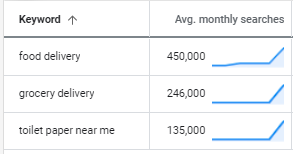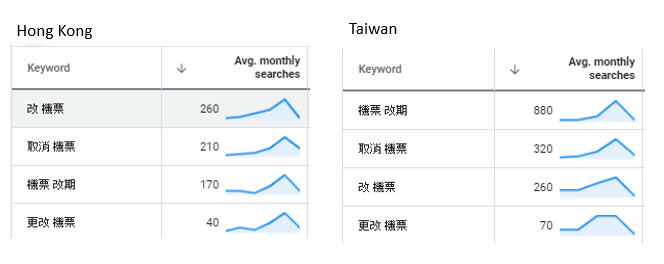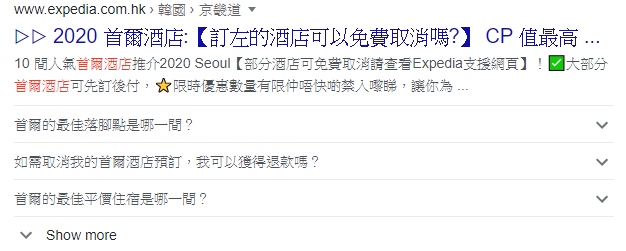In our previous blog article, we discussed why you need SEO as a long-term marketing strategy to survive the economic fallout from COVID-19.
However, in the short-term, you likely have pressure to reduce extraneous marketing spend now.
To help with your recovery and response efforts, here are 5 tips for SEO on a limited budget:
- Identify and match search intent
- Conduct and implement COVID-19-specific keyword research
- Optimize on-page content
- Optimize rich results listing
- Update Google My Business
1. Identify + match search intent
There is no doubt that people are changing their habits due to quarantine life—and hence their search intent too.
Take the US market as an example: As COVID-19 started to rapidly spread across different states in mid-March 2020, we also saw a dramatic increase in search volume for delivery services of essential goods like food and groceries as people locked down.
Search intent towards most industries and fields has changed and will continue as the situation develops.
As a goods/services provider, you should work to understand what people are actually searching for today in your market and match your customer’s needs as exactly and efficiently as possible.
From an SEO perspective, identifying search intent is the first step to understanding the latest market trends and the type of information that consumers are seeking.
You can obtain search intent insights by analyzing Google trends and news, Google Search Console, site search records, and recent online transactions to discover how your customers’ behavior is changing as people and economies work to recover.
2. Conduct + implement COVID-19-related keyword research
When identifying search intent, you can also conduct specific keyword research on which terms people use to achieve search intent. This is essential if your business has more than one market or language version.
Take the tourism industry as an example: Search intent shifted from cheap flight tickets to flexible flight tickets. However, the keywords used in different regions vary.
For example, for rescheduling flights, “改機票” is more commonly used in Hong Kong (it has the highest average monthly search volume), while “機票改期” is more commonly used in Taiwan.
As Google can now provide search volume data up to March 2020, you can already see keyword trends of what people are searching during COVID-19 and try to anticipate what may come in the months ahead.
3. Optimize on-page content
During the COVID-19 crisis, business strategies pivoted drastically due to the rapid shift in consumer behavior, and hence some pages of your site may need to be reoptimized.
For example, you may want to emphasize your delivery service or e-commerce platform. This means you would need to reoptimize the on-page content based on updated keyword research to improve page visibility on the SERP.
It is also a good idea to create a dedicated section or hub-page for COVID-19-related content that explains your company response and how it affects your customers. This can be an FAQ section, a single page, or a number of blog articles related to COVID-19.
4. Optimize rich results listing
In addition to COVID-19-related on-page optimization, you can also optimize the rich results listing to be more relevant to search intent.
For example, Expedia recently changed its metadata from “hotels near transit stations and attractions” to “hotels that have free-cancellation”. This is a good SEO example of meeting customer’s needs.
And it’s not just metadata. You can also make good use of schema markup to provide extra information on your rich result listing.
Google has introduced a beta version of a new schema markup called SpecialAnnouncement for COVID-19 announcements to appear on Google SERP.
Google surfaces updates from health and government agency sites as priority, but using SpecialAnnouncement markup on your site can still help Google understand your COVID-19 related updates, which may start to appear as Google supports more use cases.
In the meantime, you can still use other schema, such as FAQ markup, OpeningHoursSpecification markup, and EventStatus markup, to provide business updates to your customers.
5. Update Google My Business
For businesses with a local demographic, it is important to update your Google My Business listing to inform your customers of the latest operating hours, temporary closures, or any limited services due to COVID-19.
You can also add a COVID-19 update to your GMB profile, and it will pin to the top of your listing and catch users’ attention.
In the COVID-19 update, you can provide critical information, such as special arrangements, safety and hygiene measures, or even ask for support during the crisis.
COVID-19 update posts are available for all GMB profiles.
***
We can see that Google is launching and testing new features to help soften the impact of COVID-19 on organic search while trying to provide relevant results to searchers.
To maintain site visibility during this crisis and beyond, follow our 5 SEO tips for a limited budget:
- Identify and match search intent
- Conduct and implement COVID-19-specific keyword research
- Optimize on-page content
- Optimize rich results listing
- Update Google My Business
It’s also important to stay up-to-date on the latest digital marketing trends and new search features. Check out our hub-page of digital marketing resources for COVID-19 to keep apprised of latest developments.










